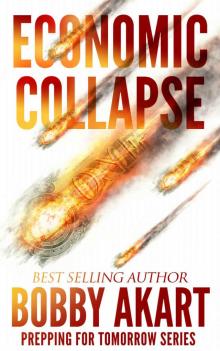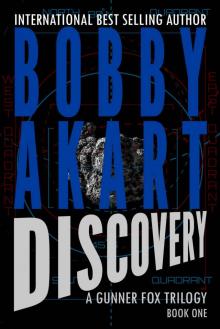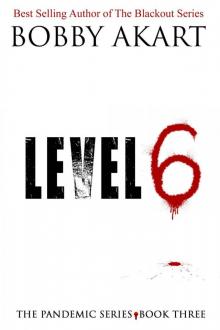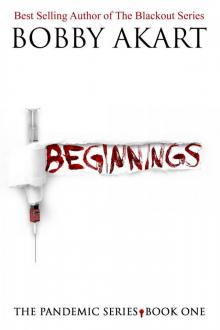- Home
- Bobby Akart
Geostorm the Shift Page 3
Geostorm the Shift Read online
Page 3
Chapman turned to the west and studied the activity taking place on Elliott Bay. Then he glanced skyward again to see that the clouds were rapidly obscuring the blue skies. He considered hustling back to the satellite truck during the break to retrieve his Land’s End parka, when the earthquake sirens began to wail.
Chapter 3
Overlooking Elliott Bay
Pier 56
Seattle, Washington
Amidst the wailing sirens, those standing near Chapman immediately studied the displays on their cell phones as the City of Seattle issued yet another warning that a crustal or shallow quake was occurring somewhere within their watch area.
He couldn’t feel anything, not that a noticeable tremor was necessary. The seismometers were very sensitive and spread throughout the Seattle Fault Zone. One could’ve been triggered on the east side of town, far away from his present location.
The crowd, gathered in the west end parking lot of Pier 56 near Elliott’s Oyster House to watch his live broadcast, were beginning to circle about, unsure what they should do. Some ran inside the restaurant, clearly ignoring the suggestions that he’d given them moments ago.
Others stood their ground, anxiously waiting to see if the quake would cause the pier to collapse into the bay. For his part, Chapman remained calm. He’d planned on asking the Seattle Emergency Management representative about their conscious effort to lower the threshold for issuing warnings due to the heavy rains. They were cognizant of the liquefaction effect of the heavy rains and were quite concerned with landslides. If a landslide was large enough, it could trigger a minor quake or, depending on its location, a small tsunami within Puget Sound and Elliott Bay.
The producer ran to his side and told him the weather desk wanted to come back to him for dramatic effect while the sirens were still sounding. He was told that according to the USGS, the tremor was felt in an isolated part of the city and that most likely there was no need for concern. Chapman immediately wondered if it was necessary to instill panic in everyone for something that minor.
He was given the one-minute countdown and prepared to go on-air again. He silently cursed the weather as a single raindrop fell on his forehead, followed by a brief burst of sunlight. The partly cloudy skies that had raised temps to a steamy 99 degrees had now dropped suddenly due to the cloud cover. His trained meteorological mind knew that a drastic change would be coming to Seattle soon.
The producer counted him down, and he assumed the position, with the concerned, hold on to your hats face.
“As you can hear, the warning sirens have been activated here in Seattle, Washington, as a potential earthquake event has been detected. The Seattle Fault Zone has long been considered dormant by comparison to similar fault lines running through California, but with the inordinate amount of rain—” Chapman stopped his reporting mid-sentence.
The sirens stopped. The restaurant patrons who were seated in the outside dining area along the pier’s railing or who’d gathered around to watch his report erupted in spontaneous applause. The unexpected show of emotion struck Chapman as odd.
He gathered himself and continued. “Well, just like that, apparently, the threat is over. I must say that people here on Seattle’s Waterfront remained calm throughout the two-minute warning blast that came via siren and cell phone. A few weren’t paying attention to my reporting and ran inside the restaurant, but for the most part, they remained calm.”
Chapman swung around to observe Elliott Bay, then continued. “As you can see, activities continue, and those taking advantage of the respite in rainfall have no intention of letting something like an earthquake dampen their spirits.”
A dark shadow suddenly crossed over Pier 56 as the cloudy skies took over. A thunderclap could be heard in the distance, echoing down Puget Sound as a harbinger of things to come.
Chapter 4
Brookfield Zoo
Chicago, Illinois
Geographically speaking, the Brookfield Zoo was located in Brookfield, Illinois, a suburb of Chicago. Unless you are a Chicagoan in your heart, the whole place was just one big, well, Chicago. To be sure, like Carol Stream, where half of Americans send their monthly credit card payments, or Cicero, where the Capone gang ran things back in the day, each hamlet of the Chicago metropolis had its own unique features.
When you think about it, one has to wonder why people from Chicago were referred to as Chicagoans in the first place other than the fact that English speakers have a tendency to add an to the tail end of a place’s name, thereby creating a demonym. You have Tennesseans, Kalamazooans, Atlantans, and naturally, Americans.
But, of course, it makes sense in the case of San Francisco, where the locals are called San Franciscans. The city was named after St. Francis of Assisi, founder of the religious order that bears his name—the Franciscans.
In any event, the Brookfield Zoo, the largest in Chicago, was world renowned for its firsts in the field of zoology. It gained international recognition in the 1930s for using moats and ditches instead of cages to separate animals from visitors and other animals. It was the first zoo in America to exhibit giant pandas. It created the first indoor dolphin exhibit, and, in the 1980s, the zoo introduced Tropic World, the first fully indoor rain forest simulation in the world.
It would also go down in history as the first zoo where the animals lost their minds.
The Brookfield Zoo was also known for its Center for Animal Welfare, established by the Chicago Zoological Society. Scientists, zoologists, and veterinarians from around the world vied for a coveted position on the team to conduct research on the wide variety of animals, as well as apply a broad range of study to evaluate animal well-being.
The head of the department, dressed in her customary white lab coat, entered the staff cafeteria, which was mostly empty that late afternoon. She was greeted by several of her peers.
“Hi, Kristi!”
“Join us when you get your food.”
“Good afternoon, Dr. Charles.”
The last greeting caused Kristi to cringe. She was no longer Dr. Charles. Oh, she was certainly a doctor of veterinary medicine. In fact, she was considered at the top of her field. However, she was no longer a Charles. The ink was still wet on her final decree of divorce. But the six-year marriage had become a dried creek bed of wasted time at least four years prior.
“No, thanks,” she responded politely. “I’m gonna grab a little something to go and a treat for Knight before I head to my office.”
She smiled as she walked by a table of veterinary students who were eager to spend a few minutes with the boss. As she did, someone at the table commented on the program being shown on the television monitor mounted in the small cafeteria.
“Can you believe that guy? He’s always in the middle of the chaos, isn’t he?”
Intrigued, Kristi glanced over her shoulder while she picked out a roast beef and swiss sandwich for herself and an apple for Knight. When she first arrived, she’d tried to adopt the vegan lifestyle of her colleagues. At first, anyway. After ten days of eating like a vegan in public, she swung through the Arby’s for a piled-high roast beef sandwich to take home for supper. You can take the girl out of the country, but you can’t take the country out of the girl. After she was named head of the department, she disregarded any pretense of being anything close to a vegan, vegetarian, or otherwise.
She stopped to watch the television after she paid for her food using the zoo-issued meal card. Like the rest of the country, paying with cash had become a thing of the past. The new currency of the world was plastic and bitcoin.
She chuckled and shook her head. “That’s my brother for ya,” she said loud enough for the cashier and those seated at the table closest to where she stood to hear. “He’s nuts like that. He’s always gotta be the center of the drama.”
“He’s cute,” remarked one of the zoology interns from Ohio State, her alma mater. “There’s something about him that’s so, um—”
“Innocent?�
� Kristi finished the young woman’s sentence. She began to laugh in earnest. “Trust me, he’s not innocent. If anything, he’s guilty of breaking every girl’s heart who has shown an interest. I don’t know when that boy will settle down, much less find love.”
“I bet I could tame him,” said another newly divorced vet on Kristi’s staff, who’d watched Fifty Shades of Grey way too many times. Kristi preferred Grey’s Anatomy to Christian Grey.
She let the comment slide and was about to head outside when one of the vets said, “You get drama, too. You got to birth a pygmy hippo.”
Okay, Kristi thought to herself, maybe she didn’t get to stand in a howling hurricane-force wind while houses and boats flew by, but she got to hold life in her hands recently. The pygmy hippopotamus calf had made her public debut a few weeks ago in the zoo’s Pachyderm House, home to tapirs from the jungles of Colombia, black rhinos from the African Savannah, and the rare pygmy hippos from the swampy forests of West Africa.
With the world watching, literally, thanks to dozens of cameras installed for the event, the twelve-year-old mother gave birth to a female calf with Kristi’s assistance.
The story garnered world attention when the mother’s mate, a fifteen-year-old male, which had become lethargic and lost his appetite, suddenly died from heart-related complications resulting from a viral infection. Days after his death, it was determined his mate, the new mother, was pregnant and the male’s legacy could live on.
Kristi was very hands-on during the birth. Her chief assistant, Rhonda, had just left to take a job in Orlando. She just couldn’t resist the lure of the Mouse and his deep pockets. Well, Kristi tried to warn her that Orlando wasn’t all it was cracked up to be, and she’d be missing out on a momentous date with the birth of an endangered species, but Rhonda left anyway.
Kristi knew the mother was almost due, as she’d monitored her eight-month gestation period religiously. When it was announced that the mother pygmy hippo was in labor, the internet blew up with excitement. Casual observers and zoologists alike tuned in to the multiple feeds broadcasted via the Chicago Zoological Society website.
When the mother barrel-rolled into the water within the habitat, Kristi carefully slid down the embankment to offer her words of encouragement. After seven hours of labor and over a hundred rolls in the water, she saw the baby emerge. Tears of joy filled her eyes as life was springing forth right in front of her. Kristi inched closer to the water and encouraged the new mother to give a final push, which she did.
The baby pygmy hippo immediately began moving and kicking in the water, and the new mom swiftly nudged it to the bank where Kristi sat in a crouch. With her assistance, the baby made its way on to the ledge, where it sprawled out and took a much-needed rest.
Ordinarily, a hippopotamus mother is fiercely protective of her young. However, the new mother had an extraordinary relationship with Kristi, one that transcended all tenets of zoology.
Thereafter, mother and child bonded, and the calf immediately took to nursing. The new mom was an old pro, nurturing her calf under water, making sure to nudge her up to the surface every thirty seconds for air to breathe.
After the experience, Kristi ordered the cameras out of the enclosure to give mom and baby the opportunity to bond privately. Since then, the pygmy hippo had grown into independence and was gaining confidence in her life at the Brookfield Zoo. Kristi Boone hoped that her post-divorce life could be just as successful.
Chapter 5
Brookfield Zoo
Chicago, Illinois
Kristi made her way to Tropic World, where some of the most interesting animals in the world were available for the Brookfield Zoo’s guests to see. Everything from the squirrel-sized New World tamarin monkey to King Kong himself, the western lowland gorilla native to the Congo and Gabon on the continent of Africa, grazed in the enormous habitat.
Visitors could browse Tropic World and meet the intelligent primates of three continents. The first stop was South America, where spider monkeys dominated the population. Next, the serenity of Asia provided onlookers a close-up look at the orangutans, and finally, the tropical forest of Africa was the location of the playful chimpanzees. In a separate enclosure, for everyone’s safety, lived the troop of gorillas led by a single male silverback together with four other gorillas and their young.
Kristi approached one of the security personnel and asked to be admitted into the Africa habitat. As per zoo protocol, she was given a Pneu-Dart tranquilizer pistol and several immobilizing darts. Kristi had stopped objecting to the protocol years ago when she was admonished by her superiors. Now, as the head of the department, she followed protocol to set a good example. Among the animal population at Brookfield Zoo, there wasn’t a single human as beloved and respected as she was. As a result, she had nothing to fear.
She found Knight lying facedown in a tire swing. He was using his muscular arms to hold onto the rope and cause the contraption to spin until it wandered toward the tree to which it was attached. Bored with the spinning sensation, he pushed himself off the trunk with his long, big-knuckled fingers until it swung outward and back.
Like most chimpanzees, Knight liked to play. He used his strong, lean arms to climb trees and propel himself from one branch to another. He especially liked his time in the Africa habitat, where he could play with the other chimps. They’d wrestle, laugh, tickle one another, and somehow converse about what things were like out there, in the real world, where Knight spent most of his time.
If Kong was considered king of the gorillas, then Knight was at the top of the intellectual scale as far as chimps were concerned. Primates were very status conscious. Knight was the only chimpanzee allowed out of the enclosure for something other than medical treatment. He, as far as his fellow chimps were concerned, was almost human, more than any other living creature.
When Knight spied Kristi enter the enclosure, he played coy with her at first. Like humans, chimps were capable of deception. Oftentimes, in Kristi’s home, they’d play a game similar to the one in the old Pink Panther movies in which Inspector Clouseau would ask to be attacked at random by his manservant, Cato. The encounter would always result in a tickle-fest and the reward of an apple for the good-natured fun.
Knight smelled Kristi’s scent before he smelled the apple. He heaved the tire swing high into the air, then back and again until, on the last attempt, he launched himself high into the air so he could reach one of the upper limbs. Then, with the grace of a trapeze artist, he flung himself across the habitat until he dropped to the ground on all fours behind Kristi.
“Hey!” she exclaimed as she swung around to face him. “You startled me.”
He howled, filling the air with the sounds of who-who and eee-eee-eee.
Kristi would have none of it. She’d raised Knight from birth to be a domesticated chimp and, in a way, a son she could never have, much to the chagrin of her mother and the now ex-husband. Over time, she got over the stigma of being a female who couldn’t have a child. She’d thought about getting a dog, but in her field of work, access to a highly intelligent chimp was the next best thing to a toddler.
She chose a name that was the subject of folklore in Indiana. Bobby Knight, the famous basketball coach from Indiana University, was an icon in the state. Certainly, there were more famous Hoosiers who were native to the state, but despite his Ohio roots, Bobby Knight was a hero to Indiana, whose name was synonymous with basketball. Plus, Knight the chimpanzee kinda reminded Kristi of the Batman character for some reason.
She stood her ground and admonished Knight to use sign language, which she’d taught him early on in his life. Six decades prior, a couple in Reno, Nevada, determined that chimpanzees might be incapable of speaking, but they were not unable to learn a language. They began to teach an infant chimp American Sign Language, the standardized language of the deaf at the time. Within five years, their chimp was not only able to achieve a vocabulary of one hundred sixty signs, but she was able to converse as wel
l. Ultimately, she could identify things that she’d never seen before by combining signs to make up a descriptive term.
Knight easily surpassed the capabilities of those early test subjects, in part because Kristi insisted upon him learning it. As a result, conversational sign language was easy for him, although he was stubborn at times when refusing to use it.
She moved her hands and fingers slowly, so as not to be misunderstood.
Use your sign language.
Knight pointed to the apple in her hand. “EEE-EEE-EEE!”
Kristi frowned and shook her head disapprovingly. She signed her response.
No. Sign language or no apple.
Knight’s shoulders drooped and he let out a sigh. He playfully smacked the side of his head and rolled over in a goofy manner. Then he responded in sign language.
Hello, Doctor. How are you today? If anyone, human or chimp, could express sign language in a sarcastic manner, Knight would have done so.
I am fine. How are you today, Knight?
I am fine. May I have the apple?
Kristi laughed and approached the playful, highly intelligent chimp. The two exchanged high fives and he quickly devoured the apple—stem, seeds, core, and all.
When he was done, he wiped his hands on the tall grass and reached up to take Kristi’s hand. She’d taught him manners, as well. Obviously, he hoped the day in the primate enclosure with the commoners was over, and he would be taken with her.
“Come on, mister man.”
“Hoot-hoot,” replied Knight, who managed a hint of swagger, glancing over his shoulder to gauge the reactions of the other chimps.
She took him by the hand, and the two inseparable pals wandered out of the enclosure, under the watchful eye of dozens of chimpanzees, who studied the entire interaction.

 Geostorm The Collapse: A Post Apocalyptic EMP Survival Thriller (The Geostorm Series Book 3)
Geostorm The Collapse: A Post Apocalyptic EMP Survival Thriller (The Geostorm Series Book 3) Doomsday Apocalypse
Doomsday Apocalypse Nuclear Winter Desolation: Post Apocalyptic Survival Thriller (Nuclear Winter Series Book 5)
Nuclear Winter Desolation: Post Apocalyptic Survival Thriller (Nuclear Winter Series Book 5) Economic Collapse (Prepping for Tomorrow Book 2)
Economic Collapse (Prepping for Tomorrow Book 2) Nuclear Winter Armageddon
Nuclear Winter Armageddon Nuclear Winter Devil Storm
Nuclear Winter Devil Storm Virus Hunters 3: A Medical Thriller
Virus Hunters 3: A Medical Thriller Doomsday Civil War: A Post-Apocalyptic Survival Thriller (The Doomsday Series Book 5)
Doomsday Civil War: A Post-Apocalyptic Survival Thriller (The Doomsday Series Book 5) Asteroid Destruction
Asteroid Destruction Geostorm the Shift
Geostorm the Shift Asteroid Discovery
Asteroid Discovery Virus Hunters 2: A Medical Thriller
Virus Hunters 2: A Medical Thriller Geostorm The Shift: A Post-Apocalyptic EMP Survival Thriller (The Geostorm Series Book 1)
Geostorm The Shift: A Post-Apocalyptic EMP Survival Thriller (The Geostorm Series Book 1) Asteroid Diversion
Asteroid Diversion Nuclear Winter Devil Storm: Post Apocalyptic Survival Thriller (Nuclear Winter Series Book 4)
Nuclear Winter Devil Storm: Post Apocalyptic Survival Thriller (Nuclear Winter Series Book 4) Geostorm The Pulse: A Post Apocalyptic EMP Survival Thriller (The Geostorm Series Book 2)
Geostorm The Pulse: A Post Apocalyptic EMP Survival Thriller (The Geostorm Series Book 2) Yellowstone: Survival: A Post-Apocalyptic Survival Thriller (The Yellowstone Series Book 4)
Yellowstone: Survival: A Post-Apocalyptic Survival Thriller (The Yellowstone Series Book 4) Nuclear Winter First Strike: Post-Apocalyptic Survival Thriller
Nuclear Winter First Strike: Post-Apocalyptic Survival Thriller Nuclear Winter Whiteout
Nuclear Winter Whiteout Doomsday Anarchy
Doomsday Anarchy Pandemic: Level 6: A Post Apocalyptic Medical Thriller Fiction Series (The Pandemic Series Book 3)
Pandemic: Level 6: A Post Apocalyptic Medical Thriller Fiction Series (The Pandemic Series Book 3) Martial Law
Martial Law Odessa Reborn: A Terrorism Thriller (Gunner Fox Book 4)
Odessa Reborn: A Terrorism Thriller (Gunner Fox Book 4) New Madrid Earthquake
New Madrid Earthquake Beyond Borders: Post Apocalyptic EMP Survival Fiction (The Lone Star Series Book 2)
Beyond Borders: Post Apocalyptic EMP Survival Fiction (The Lone Star Series Book 2) The Blackout Series (Book 3): Turning Point
The Blackout Series (Book 3): Turning Point Patriot's Farewell: A Political Thriller Fiction Series (Boston Brahmin Political Thrillers Book 7)
Patriot's Farewell: A Political Thriller Fiction Series (Boston Brahmin Political Thrillers Book 7) Lines in the Sand_Post Apocalyptic EMP Survival Fiction
Lines in the Sand_Post Apocalyptic EMP Survival Fiction The Mechanics: A Post-Apocalyptic Fiction Series
The Mechanics: A Post-Apocalyptic Fiction Series The Loyal Nine
The Loyal Nine Axis of Evil
Axis of Evil Axis of Evil: Post Apocalyptic EMP Survival Fiction (The Lone Star Series Book 1)
Axis of Evil: Post Apocalyptic EMP Survival Fiction (The Lone Star Series Book 1) Lines in the Sand: Post Apocalyptic EMP Survival Fiction (The Lone Star Series Book 3)
Lines in the Sand: Post Apocalyptic EMP Survival Fiction (The Lone Star Series Book 3) Odessa Strikes
Odessa Strikes The Blackout Series (Book 4): Shiloh Ranch
The Blackout Series (Book 4): Shiloh Ranch Hornet's Nest: A Post Apocalyptic EMP Survival Fiction Series (The Blackout Series Book 5)
Hornet's Nest: A Post Apocalyptic EMP Survival Fiction Series (The Blackout Series Book 5) Yellowstone: Fallout: A Post-Apocalyptic Survival Thriller (The Yellowstone Series Book 3)
Yellowstone: Fallout: A Post-Apocalyptic Survival Thriller (The Yellowstone Series Book 3) Electromagnetic Pulse
Electromagnetic Pulse Texas Strong: Post Apocalyptic EMP Survival Fiction (The Lone Star Series Book 4)
Texas Strong: Post Apocalyptic EMP Survival Fiction (The Lone Star Series Book 4) Fifth Column_Post Apocalyptic EMP Survival Fiction
Fifth Column_Post Apocalyptic EMP Survival Fiction Patriot's Farewell
Patriot's Farewell Texas Strong_Post Apocalyptic EMP Survival Fiction
Texas Strong_Post Apocalyptic EMP Survival Fiction Pandemic: The Innocents: A Post-Apocalyptic Medical Thriller Fiction Series (The Pandemic Series Book 2)
Pandemic: The Innocents: A Post-Apocalyptic Medical Thriller Fiction Series (The Pandemic Series Book 2) Shiloh Ranch: A Post Apocalyptic EMP Survival Fiction Series (The Blackout Series Book 4)
Shiloh Ranch: A Post Apocalyptic EMP Survival Fiction Series (The Blackout Series Book 4) Cyber Attack
Cyber Attack Beyond Borders
Beyond Borders Choose Freedom: A Post-Apocalyptic Fiction Series (The Boston Brahmin Book 6)
Choose Freedom: A Post-Apocalyptic Fiction Series (The Boston Brahmin Book 6) False Flag
False Flag Turning Point: A Post Apocalyptic EMP Survival Fiction Series (The Blackout Series Book 3)
Turning Point: A Post Apocalyptic EMP Survival Fiction Series (The Blackout Series Book 3) Nuclear Winter First Strike
Nuclear Winter First Strike Pandemic: Beginnings: A Post-Apocalyptic Medical Thriller Fiction Series (The Pandemic Series Book 1)
Pandemic: Beginnings: A Post-Apocalyptic Medical Thriller Fiction Series (The Pandemic Series Book 1) Devil's Homecoming: A Post Apocalyptic EMP Survival Fiction Series (The Blackout Series Book 6)
Devil's Homecoming: A Post Apocalyptic EMP Survival Fiction Series (The Blackout Series Book 6) The Blackout Series (Book 6): Devil's Homecoming
The Blackout Series (Book 6): Devil's Homecoming Yellowstone: Inferno: A Post-Apocalyptic Survival Thriller (The Yellowstone Series Book 2)
Yellowstone: Inferno: A Post-Apocalyptic Survival Thriller (The Yellowstone Series Book 2) Fifth Column: Post Apocalyptic EMP Survival Fiction (The Lone Star Series Book 5)
Fifth Column: Post Apocalyptic EMP Survival Fiction (The Lone Star Series Book 5) Yellowstone: Hellfire: A Post-Apocalyptic Survival Thriller (The Yellowstone Series Book 1)
Yellowstone: Hellfire: A Post-Apocalyptic Survival Thriller (The Yellowstone Series Book 1) The Blackout Series (Book 2): Zero Hour
The Blackout Series (Book 2): Zero Hour Suicide Six: Post Apocalyptic EMP Survival Fiction (The Lone Star Series Book 6)
Suicide Six: Post Apocalyptic EMP Survival Fiction (The Lone Star Series Book 6) Suicide Six_Post Apocalyptic EMP Survival Fiction
Suicide Six_Post Apocalyptic EMP Survival Fiction Zero Hour: A Post-Apocalyptic EMP Survival Fiction Series (The Blackout Series Book 2)
Zero Hour: A Post-Apocalyptic EMP Survival Fiction Series (The Blackout Series Book 2) Beyond Borders_Post Apocalyptic EMP Survival Fiction
Beyond Borders_Post Apocalyptic EMP Survival Fiction Pandemic: Quietus: A Post-Apocalyptic Dystopian Fiction Series (The Pandemic Series Book 4)
Pandemic: Quietus: A Post-Apocalyptic Dystopian Fiction Series (The Pandemic Series Book 4) 36 Hours: A Post-Apocalyptic EMP Survival Fiction Series
36 Hours: A Post-Apocalyptic EMP Survival Fiction Series Cyber Warfare
Cyber Warfare